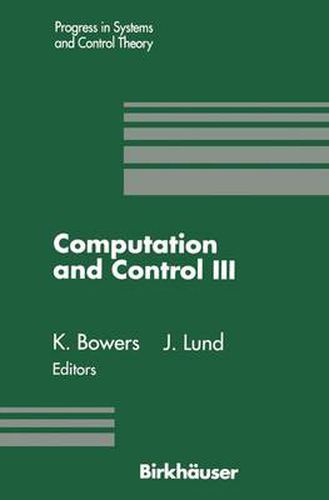Readings Newsletter
Become a Readings Member to make your shopping experience even easier.
Sign in or sign up for free!
You’re not far away from qualifying for FREE standard shipping within Australia
You’ve qualified for FREE standard shipping within Australia
The cart is loading…






This title is printed to order. This book may have been self-published. If so, we cannot guarantee the quality of the content. In the main most books will have gone through the editing process however some may not. We therefore suggest that you be aware of this before ordering this book. If in doubt check either the author or publisher’s details as we are unable to accept any returns unless they are faulty. Please contact us if you have any questions.
The third Conference on Computation and Control was held at Mon tana State University in Bozeman, Montana from August 5-11, 1992 and this proceedings represents the evolution that the conference has taken since its 1988 and 1990 predecessors. The first conference and proceedings (Volume 1 in PSCT) nurtured a dialogue between researchers in control theory and the area of numerical computation. This cross-fertilization was continued with the 1990 conference and proceedings (Volume 11 in PSCT) while forecasting the theme for this conference. The present volume contains a collection of papers addressing issues ranging from noise abatement via smart material technology, robotic vi sion, and parameter identification to feedback design challenges in fluid control and other areas of topical interest. The area of feedback design in fluid control spawns computational challenges in the form of Burgers’ equation which is addressed both with standard numerical methods as well as new computational procedures. Applications which involve inverse prob lems include material parameter estimation and sampling in observability. Whether motivated by the plant or arising as the distributed system in the design of a feedback compensator for problems in nonlinear control, the theme of this conference placed an emphasis on the use of partial dif ferential equations in control theory. Through challenges initiated via the control problem or the subsequent computational problem, the joint efforts of experts from the respective disciplines enhance the development of both.
$9.00 standard shipping within Australia
FREE standard shipping within Australia for orders over $100.00
Express & International shipping calculated at checkout
This title is printed to order. This book may have been self-published. If so, we cannot guarantee the quality of the content. In the main most books will have gone through the editing process however some may not. We therefore suggest that you be aware of this before ordering this book. If in doubt check either the author or publisher’s details as we are unable to accept any returns unless they are faulty. Please contact us if you have any questions.
The third Conference on Computation and Control was held at Mon tana State University in Bozeman, Montana from August 5-11, 1992 and this proceedings represents the evolution that the conference has taken since its 1988 and 1990 predecessors. The first conference and proceedings (Volume 1 in PSCT) nurtured a dialogue between researchers in control theory and the area of numerical computation. This cross-fertilization was continued with the 1990 conference and proceedings (Volume 11 in PSCT) while forecasting the theme for this conference. The present volume contains a collection of papers addressing issues ranging from noise abatement via smart material technology, robotic vi sion, and parameter identification to feedback design challenges in fluid control and other areas of topical interest. The area of feedback design in fluid control spawns computational challenges in the form of Burgers’ equation which is addressed both with standard numerical methods as well as new computational procedures. Applications which involve inverse prob lems include material parameter estimation and sampling in observability. Whether motivated by the plant or arising as the distributed system in the design of a feedback compensator for problems in nonlinear control, the theme of this conference placed an emphasis on the use of partial dif ferential equations in control theory. Through challenges initiated via the control problem or the subsequent computational problem, the joint efforts of experts from the respective disciplines enhance the development of both.